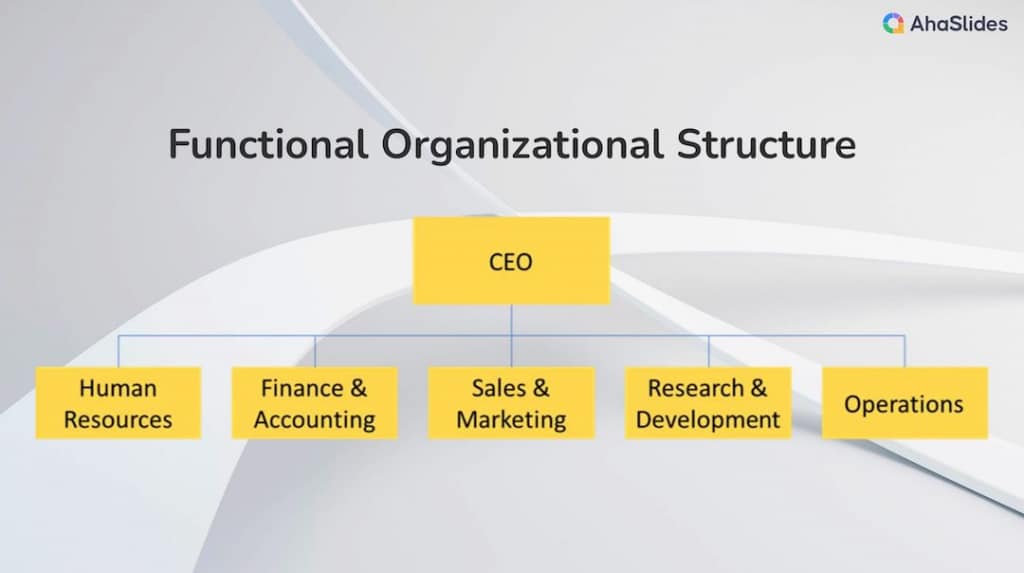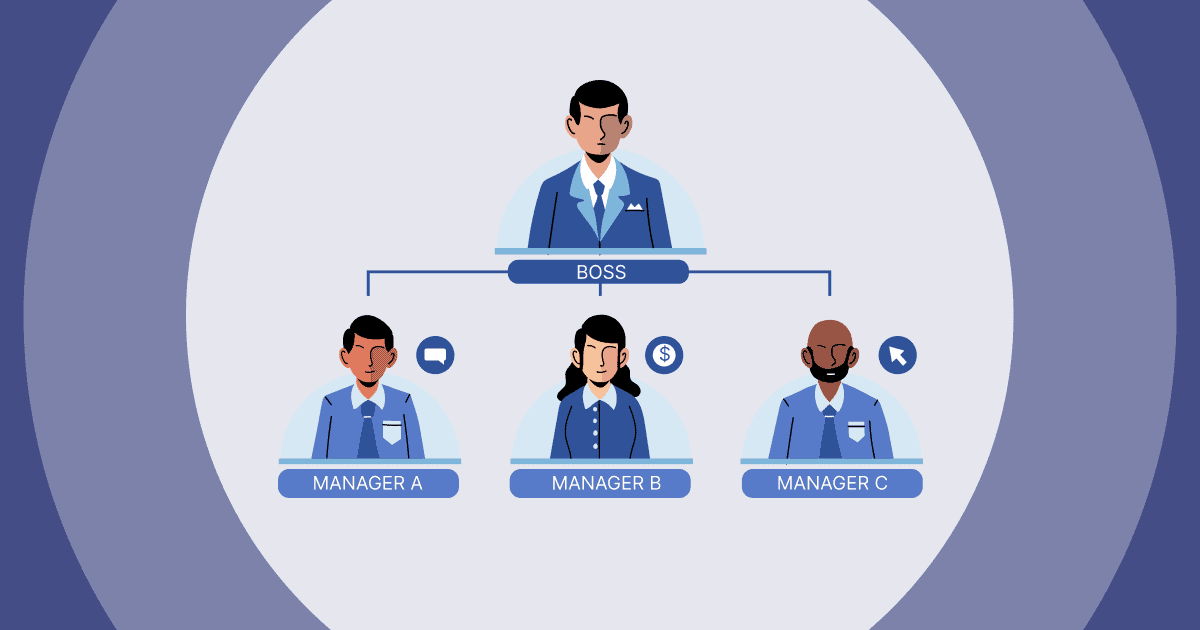Heb je je ooit afgevraagd hoe grote bedrijven zichzelf organiseren te midden van alle bewegende delen?
Hoewel sommige bedrijven als één samenhangende eenheid opereren, richten veel bedrijven afzonderlijke afdelingen op op basis van hun functie. Dit staat bekend als een functionele organisatiestructuur.
Of het nu gaat om marketing, financiën, operations of IT, functionele structuren verdelen teams op basis van specialiteit.
Op het eerste gezicht lijkt deze scheiding van taken duidelijk, maar welke impact heeft dit nu echt op de samenwerking, de besluitvorming en de algehele bedrijfsvoering?
In dit bericht nemen we een kijkje onder de motorkap van het functionele model en de voordelen ervan. Duik er meteen in!
| Wat zijn voorbeelden van functionele organisaties? | Schaalbaar, Starbucks, Amazon. |
| Welk type organisatie past goed bij een functionele organisatiestructuur? | Grote bedrijven. |
Inhoudsopgave
- Wat is een functionele organisatiestructuur?
- Voordelen van functionele organisatiestructuur
- Nadelen van functionele organisatiestructuur
- De uitdagingen van een functionele organisatiestructuur overwinnen
- Wanneer is een functionele structuur geschikt?
- Voorbeelden van functionele organisatiestructuur
- Key Takeaways
- Veelgestelde Vragen / FAQ
Meer tips met AhaSlides

Op zoek naar meer plezier tijdens bijeenkomsten?
Verzamel je teamleden voor een leuke quiz op AhaSlides. Meld je aan voor een gratis quiz uit de sjablonenbibliotheek van AhaSlides!
🚀 Grijp gratis quiz☁️
Wat is een functionele organisatiestructuur?

Veel bedrijven kiezen ervoor om zichzelf in verschillende afdelingen te organiseren op basis van de soorten banen of taken die mensen doen, en verdelen het werk in meer gespecialiseerde banen.
Dit wordt een “ hebben” genoemdfunctionele organisatiestructuurIn plaats van iedereen die aan hetzelfde project werkt bij elkaar te zetten, worden mensen gegroepeerd op basis van hun algemene werkgebied – zaken als marketing, financiën, operations, klantenservice, enzovoort.
Iedereen die bijvoorbeeld advertenties maakt, campagnes op sociale media voert of nieuwe productideeën bedenkt, bevindt zich op de marketingafdeling. Alle accountants die geld bijhouden, rekeningen betalen en belastingen indienen, zouden samen in de financiële wereld zitten. Ingenieurs zouden tijdens operaties samen met andere ingenieurs werken.
Het idee is dat door iedereen met vergelijkbare vaardigheden bij elkaar te zetten, ze elkaar kunnen helpen en van elkaars expertise kunnen leren. Dingen zoals financiële procedures kunnen ook over de hele afdeling worden gestandaardiseerd.
Deze structuur is zeer efficiënt, omdat specialisten niet constant buiten hun eigen afdeling naar antwoorden hoeven te zoeken. Het kan echter ook lastig zijn voor verschillende afdelingen om goed samen te werken aan grotere projecten die veel vaardigheden vereisen. Ook de communicatie tussen afdelingen kan soms verwateren.
Over het algemeen zijn functionele structuren goed voor gevestigde bedrijven waar processen zijn vastgelegd, maar bedrijven moeten manieren vinden om mensen ook afdelingsoverstijgend bij elkaar te brengen om te voorkomen dat ze in hun eigen systeem moeten werken. silo's te veel.
Voordelen van functionele organisatiestructuur

De belangrijkste voordelen van een functionele organisatiestructuur worden hieronder besproken:
- Specialisatie van arbeid – Mensen verwerven expertise in hun specifieke functie door zich uitsluitend op die taken te concentreren. Dit leidt tot een hogere productiviteit.
- Centralisatie van expertise – Binnen elke afdeling wordt vergelijkbare expertise gebundeld. Medewerkers kunnen van elkaar leren en elkaar ondersteunen.
- Standaardisatie van werkwijzen – Binnen elke functie kunnen gemeenschappelijke werkwijzen worden ontwikkeld en gedocumenteerd voor consistentie.
- Duidelijke rapportagelijnen – Het is duidelijk aan wie medewerkers rapporteren op basis van hun rol, zonder matrixrapportage aan meerdere managers. Dit stroomlijnt de besluitvorming.
- Flexibele toewijzing van middelen – Arbeid en kapitaal kunnen gemakkelijker binnen afdelingen worden verschoven op basis van veranderende prioriteiten en werklast.
- Schaalvoordeel – Middelen zoals apparatuur en werknemers kunnen binnen elke afdeling worden gedeeld, waardoor de kosten per eenheid product worden verlaagd.
- Gemakkelijker toezicht houden op prestaties – Afdelingsstatistieken kunnen duidelijker worden gekoppeld aan doelen en resultaten, omdat de functies gescheiden zijn.
- Carrièreontwikkelingsmogelijkheden – Werknemers kunnen hun vaardigheden en carrière verder ontwikkelen door te switchen tussen functies binnen hun vakgebied.
- Vereenvoudiging van het management – Elke afdelingshoofd heeft zeggenschap over één homogene eenheid, waardoor het management minder complex wordt.
Samenvattend bevordert een functionele structuur specialisatie, het benutten van expertise en operationele efficiëntie binnen individuele functies.
Nadelen van functionele organisatiestructuur

Aan de andere kant van de medaille is een functionele organisatiestructuur niet geheel foutloos. Bedrijven moeten rekening houden met deze potentiële tegenslagen:
- Silomentaliteit – Afdelingen richten zich vaak alleen op hun eigen doelen in plaats van op die van de organisatie als geheel. Dit belemmert de samenwerking.
- Duplicatie van werkzaamheden – Dezelfde taken worden mogelijk herhaaldelijk in verschillende afdelingen uitgevoerd in plaats van gestroomlijnd over functies.
- Trage besluitvorming – Problemen die afdelingen overstijgen, duren langer om op te lossen omdat er coördinatie tussen afdelingen nodig is.
- Slechte klantenservice – Klanten die met meerdere afdelingen te maken hebben, krijgen mogelijk een inconsistente of gefragmenteerde ervaring.
- Complexe processen – Werk dat cross-functionele samenwerking vereist, kan verwarrend, inefficiënt en frustrerend worden.
- Onbuigzaamheid ten opzichte van verandering – Het is moeilijk om snel middelen te verschuiven en aan te passen als de marktbehoeften veranderen of als er nieuwe kansen ontstaan.
- Moeilijkheden bij het evalueren van afwegingen – De bredere gevolgen van functionele beslissingen kunnen over het hoofd worden gezien als er geen rekening wordt gehouden met onderlinge afhankelijkheden.
- Te veel afhankelijkheid van leidinggevenden – Werknemers zijn te afhankelijk van hun afdelingsleider in plaats van dat ze een breder perspectief ontwikkelen.
- Onderdrukte innovatie – Nieuwe ideeën die input uit verschillende hoeken vereisen, krijgen moeilijker steun.
Functionele silo's, trage besluitvorming en een gebrek aan samenwerking kunnen de efficiëntie en flexibiliteit ondermijnen voor een organisatie met deze structuur.
De uitdagingen van een functionele organisatiestructuur overwinnen
Het kan lastig zijn voor verschillende werkgroepen, zoals marketing, sales en support, om contact te leggen als ze altijd in hun eigen hoekje zitten. Maar isolatie maakt het juist lastig om dingen gedaan te krijgen. Hier zijn een paar ideeën om deze uitdagingen te overwinnen:
Maak projecten met mensen uit verschillende gebieden. Hiermee stelt u iedereen voor en helpt u elkaar.
Kies mensen om eenheden te helpen zich te binden. Stel product-/klantmanagers aan, zij zorgen ervoor dat iedereen updates deelt en samen problemen oplost.
Concentreer u op gedeelde doelen, in plaats van dat elk gebied zijn eigen ding doet, en sluit u aan bij de dromen van grote bedrijven die ze allemaal ondersteunen.
Consolideer dubbele rollen, zoals HR of IT, zodat één team al het werk bedient in plaats van het werk te verdelen.
Organiseer bijeenkomsten waarin afdelingen elkaar kort bijpraten over de stand van zaken. Pak problemen in de kiem aan.

Investeer in hulpmiddelen voor samenwerking: technologieën zoals intranetten, documenten/bestandsdeling en apps voor projectbeheer kunnen de coördinatie vergemakkelijken.
Bevorder flexibele rotaties. Laat de medewerkers tijdelijk andere rollen elders uitproberen om elkaar beter te begrijpen en een ander perspectief te ontwikkelen.
Houd ook het teamwork in de gaten. Let op hoe goed mensen met elkaar overweg kunnen en op de algemene KPI's van het team, niet alleen op individuele prestaties. Stimuleer leiders om zich te richten op organisatorische synergie, niet alleen op functionele KPI's.
Stimuleer ten slotte sociale interactie, zodat elke afdeling zich meer op haar gemak voelt bij het benaderen van elkaar voor hulp. Het vinden van manieren waarop functies met elkaar kunnen communiceren en als een onderling afhankelijk geheel kunnen werken, zal helpen silo's af te breken.
Breek het ijs met AhaSlides
Help elke afdeling verbinding te maken en een band op te bouwen met de interactiviteiten van AhaSlides. Onmisbaar voor de bindingssessies van bedrijven!🤝

Wanneer is een functionele structuur geschikt?

Bekijk de lijst om te zien of uw organisatie geschikt is om deze structuur te vormen:
☐ Gevestigde bedrijven met gestandaardiseerde werkwijzen – Bij volwassen bedrijven waarvan de kernprocessen en workflows goed gedefinieerd zijn, kan specialisatie binnen functies de efficiëntie bevorderen.
☐ Stabiele zakelijke omgeving – Als de markt en de behoeften van klanten relatief voorspelbaar zijn, kunnen functionele groepen zich richten op het optimaliseren van hun specialistische gebieden zonder dat er snelle samenwerking tussen afdelingen nodig is.
☐ Taken waarvoor gespecialiseerde expertise vereist is – Bepaalde banen, zoals techniek, boekhouding of juridisch werk, zijn sterk afhankelijk van diepgaande technische vaardigheden en passen goed bij een functionele structuur.
☐ Prioriteren van operationele uitvoering – Functionele structuren zijn uiterst efficiënt wanneer de organisatie prioriteit geeft aan het produceren of leveren van een product of dienst; door gespecialiseerde stappen tussen functies te scheiden, kan de uitvoering worden gestroomlijnd.
☐ Grote organisaties met schaal – Zeer grote bedrijven met duizenden werknemers kunnen zich in functies organiseren om de complexiteit over meerdere bedrijfseenheden te beheren.
☐ De toewijzing van middelen is het belangrijkst – Voor kapitaalintensieve industrieën werkt een structuur die een nauwkeurige toewijzing van gespecialiseerde middelen en apparatuur mogelijk maakt, goed.
☐ Traditioneel bureaucratische culturen – Sommige gevestigde bedrijven geven de voorkeur aan sterk op afdelingen gebaseerde structuren voor controle en toezicht.
Voorbeelden van functionele organisatiestructuur

Technologiebedrijf:
- Afdeling Marketing
- Technische afdeling
- Afdeling productontwikkeling
- Afdeling IT/Operations
- Verkoopafdeling
- Afdeling Klantenondersteuning
Productiebedrijf:
- Afdeling Productie/Operations
- Technische afdeling
- Inkoopafdeling
- Afdeling kwaliteitscontrole
- Afdeling Logistiek/Distributie
- Verkoop- en marketingafdeling
- Afdeling Financiën en Boekhouding
Ziekenhuis:
- Verpleegkundige afdeling
- Afdeling Radiologie
- Chirurgie afdeling
- Afdeling Laboratoria
- Apotheek afdeling
- Administratieve/factureringsafdeling
Detailhandel:
- Afdeling winkeloperaties
- Afdeling merchandising/inkoop
- Afdeling Marketing
- Afdeling Financiën/boekhouding
- HR afdeling
- Afdeling Schadepreventie
- IT afdeling
Universiteit:
- Verschillende academische afdelingen zoals biologie, Engels, geschiedenis en dergelijke
- Afdeling Studentenzaken
- Facilitaire afdeling
- Gesponsorde onderzoeksafdeling
- Atletiek afdeling
- Financiële en administratieve afdeling
Dit zijn enkele voorbeelden van hoe bedrijven in verschillende sectoren gespecialiseerde rollen en functies in afdelingen kunnen groeperen om een functionele organisatiestructuur te vormen.
Key Takeaways
Hoewel het verdelen van werk in gespecialiseerde afdelingen voordelen heeft, kunnen er gemakkelijk silo's tussen groepen ontstaan. Om echt succesvol te zijn, hebben bedrijven net zoveel samenwerking als specialismen nodig.
Uiteindelijk zitten we allemaal in hetzelfde team. Of je nu producten maakt of klantenservice levert, je werk ondersteunt anderen en de algehele missie van het bedrijf.
👏 Zie ook: De 7 soorten organisatiestructuren Je moet weten.
Veelgestelde Vragen / FAQ
Wat zijn de 4 functionele organisatiestructuren?
De vier functionele organisatiestructuren zijn functionele, divisie-, matrix- en netwerkstructuur.
Wat wordt bedoeld met functionele structuur?
Een functionele organisatiestructuur verwijst naar de manier waarop een bedrijf zijn arbeid en afdelingen verdeelt op basis van de functies of werklijnen die daarbij betrokken zijn.
Heeft McDonald's een functionele organisatiestructuur?
McDonald's heeft een organisatiestructuur met divisies. Iedere divisie bedient een specifieke geografische locatie en opereert vrijwel onafhankelijk met zijn eigen afdelingen, zoals marketing, verkoop, financiën, juridische zaken, bevoorrading, enzovoort.







